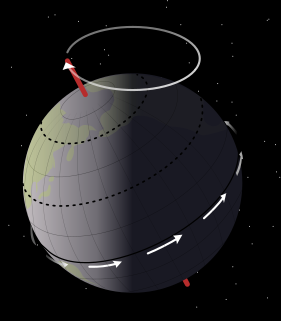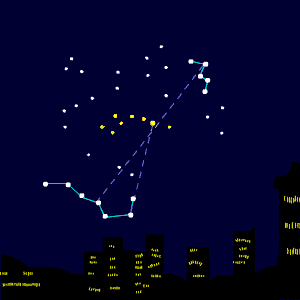This article does not cite any sources .(December 2009) (Learn how and when to remove this template message) |
The Regiment of the North Pole, an outdated astronomy term, is a rule saying how to find the celestial North Pole by the stars. It was used in former centuries when, because of precession, the star Polaris was much further from the celestial North Pole than it is now.

Astronomy is a natural science that studies celestial objects and phenomena. It applies mathematics, physics, and chemistry in an effort to explain the origin of those objects and phenomena and their evolution. Objects of interest include planets, moons, stars, nebulae, galaxies, and comets; the phenomena also includes supernova explosions, gamma ray bursts, quasars, blazars, pulsars, and cosmic microwave background radiation. More generally, all phenomena that originate outside Earth's atmosphere are within the purview of astronomy. A branch of astronomy called cosmology is the study of the Universe as a whole.

The North Pole, also known as the Geographic North Pole or Terrestrial North Pole, is defined as the point in the Northern Hemisphere where the Earth's axis of rotation meets its surface.

Precession is a change in the orientation of the rotational axis of a rotating body. In an appropriate reference frame it can be defined as a change in the first Euler angle, whereas the third Euler angle defines the rotation itself. In other words, if the axis of rotation of a body is itself rotating about a second axis, that body is said to be precessing about the second axis. A motion in which the second Euler angle changes is called nutation. In physics, there are two types of precession: torque-free and torque-induced.
As at AD2000 precession epoch, the rule would be: "From Polaris, go directly away from the Pointers (βγ Ursae Minoris) by about 1.45 times the apparent diameter of the Full Moon."
In astronomy, an epoch is a moment in time used as a reference point for some time-varying astronomical quantity, such as the celestial coordinates or elliptical orbital elements of a celestial body, because these are subject to perturbations and vary with time. These time-varying astronomical quantities might include, for example, the mean longitude or mean anomaly of a body, the node of its orbit relative to a reference plane, the direction of the apogee or aphelion of its orbit, or the size of the major axis of its orbit.

Polaris, designated α Ursae Minoris, commonly the North Star or Pole Star, is the brightest star in the constellation of Ursa Minor. It is very close to the north celestial pole, making it the current northern pole star. The revised Hipparcos parallax gives a distance to Polaris of about 433 light-years, while calculations by other methods derive distances around 30% closer.

Ursa Minor, also known as the Little Bear, is a constellation in the Northern Sky. Like the Great Bear, the tail of the Little Bear may also be seen as the handle of a ladle, hence the North American name, Little Dipper: seven stars with four in its bowl like its partner the Big Dipper. It was one of the 48 constellations listed by the 2nd-century astronomer Ptolemy, and remains one of the 88 modern constellations. Ursa Minor has traditionally been important for navigation, particularly by mariners, because of Polaris being the North Star.
| This astronomy-related article is a stub. You can help Wikipedia by expanding it. |












